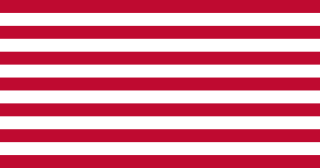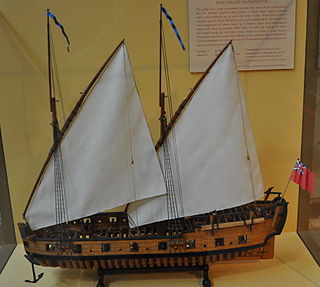
Lake Champlain is a natural freshwater lake in North America. It mostly lies between the US states of New York and Vermont, but also extends north into the Canadian province of Quebec.

The Battle of Valcour Island, also known as the Battle of Valcour Bay, was a naval engagement that took place on October 11, 1776, on Lake Champlain. The main action took place in Valcour Bay, a narrow strait between the New York mainland and Valcour Island. The battle is generally regarded as one of the first naval battles of the American Revolutionary War, and one of the first fought by the United States Navy. Most of the ships in the American fleet under the command of Benedict Arnold were captured or destroyed by a British force under the overall direction of General Guy Carleton. However, the American defense of Lake Champlain stalled British plans to reach the upper Hudson River valley.
USS Enterprise was a Continental Army sloop-of-war that served in Lake Champlain during the American Revolutionary War. She was the first of a long and prestigious line of ships of the United States or by the combatant forces of the U.S. Revolutionary War to bear the name Enterprise.

The Continental Navy was the navy of the Thirteen Colonies during the American Revolutionary War. Founded on October 13, 1775, the fleet developed into a relatively substantial force throughout the Revolutionary War, owing partially to the substantial efforts of the Continental Navy's patrons within the Continental Congress. These Congressional Patrons included the likes of John Adams, who served as the Chairman of the Naval Committee until 1776, when Commodore Esek Hopkins received instruction from the Continental Congress to assume command of the force.

The first USS Revenge was a Schooner in the Continental Navy. Revenge was built in the summer of 1776 by Colonel Jeduthan Baldwin at Fort Ticonderoga, New York.

The Pennsylvania Navy served as the naval force of Pennsylvania during the American Revolution and afterward, until the formation of the United States Navy. The navy's vessels served almost exclusively on the Delaware River, and were active in first defending the approaches to the city of Philadelphia during the British campaign that successfully occupied the city in 1777, and then preventing the Royal Navy from resupplying the occupying army.
David Hawley (1741–1807) was a captain in the Continental Navy and a privateer during the American Revolutionary War. He commanded Royal Savage in the 1776 Battle of Valcour Island, which is generally regarded as one of the first naval battles of the American Revolutionary War, and one of the first fought by the United States Navy.

USS Philadelphia is a gunboat of the Continental Navy. She was constructed from July–August 1776 for service during the American Revolutionary War. Manned by Continental Army soldiers, she was part of a fleet under the command of General Benedict Arnold that fought against the British Royal Navy in the Battle of Valcour Island on Lake Champlain. Philadelphia was sunk during the battle on 11 October 1776.
USS Trumbull may refer to the following ships of the United States Navy:

The first USS Boston was a gundalow built at Skenesborough, New York, in 1776, with a crew of 45 for General Benedict Arnold's short-lived Lake Champlain Fleet. She took part in the Battle of Valcour Island that delayed the British invasion. She was probably commissioned sometime early in August 1776, with a Captain Sumner in command.

USS Washington was a large row galley, with a rowing crew of 60, that was placed into service under the control of the Continental Congress in 1776. During this age of sail, row galleys were highly maneuverable compared to sailing ships whose movements were dependent on the wind. Washington's war record consisted of an attack on several British warships, and, after finding itself on the losing side of the battle, the row galley rowed away, out of danger. There is no further report of her efforts for the Continental Navy.
USS Spitfire was a row galley authorized and constructed by Rhode Island during the American Revolution, and was placed in service in 1776 in the Rhode Island Navy. During this age of sail, row galleys were highly maneuverable compared to sailing ships whose movements were dependent on the wind. Spitfire had a reportedly successful career, helping to capture British cargo ships and engaging in the fight against British warships.

USS Washington was a lateen-rigged, two-masted galley in the service of the Continental Congress during the American Revolutionary War. Washington was capable of propulsion by sail or by the rowing of oarsmen. During a battle with British warships, Washington "struck her colors" and was captured by the British.
USS Providence, a gundalow, was built at Skenesboro, New York, on Lake Champlain by the Continental Army for Brigadier-General Benedict Arnold's fleet on Lake Champlain in 1776, during the American Revolutionary War.
USS Lee was a galley built for the Continental Navy during the American Revolution. She participated in the Battle of Valcour Island during which she was grounded and lost. However, her participation in the battle helped delay the British advance on New York City by a year.
USS Spitfire was an American gundalow that operated as a gunboat in 1776 on Lake Champlain. She was part of Benedict Arnold's small, hastily built fleet of ships whose purpose was to counter any British invasion forces passing through the lake from Canada. Her service life was brief; after only a few months patrolling the lake she was lost in the aftermath of the Battle of Valcour Island. The gunboat's wreck was located and documented in the 1990s by the Lake Champlain Maritime Museum.

American colonial marines were various naval infantry units which served during the Revolutionary War on the Patriot side. After the conflict broke out in 1775, nine of the rebelling Thirteen Colonies established state navies to carry out naval operations. Accordingly, several marine units were raised to serve as an infantry component aboard the ships of these navies. The marines, along with the navies they served in, were intended initially as a stopgap measure to provide the Patriots with naval capabilities before the Continental Navy reached a significant level of strength. After its establishment, state navies, and the marines serving in them, participated in several operations alongside the Continental Navy and its marines.
New York (1776) was a gunboat built in 1776 at Skenesboro, New York. It was originally called Success prior to launch for service in General Benedict Arnold's fleet on Lake Champlain. New York may be named after the City of New York, because other ships in the fleet were named after cities, however, it could be named after the State of New York, because at least one or two other ships, Connecticut and Jersey, sometimes referred to as New Jersey, were named after states.

Royal Savage was a two-masted schooner built by the British in the summer of 1775. She was damaged and sunk by soldiers of the United Colonies during the Siege of Fort St. Jean and later raised and repaired after the fort was captured. She then participated in General Benedict Arnold's campaign on Lake Champlain. The British captured and burnt her in October 1776 at Valcour Island.
The first USS Trumbull was a row galley built in 1776 at Skenesboro, New York, for service in General Benedict Arnold's fleet on Lake Champlain. She was launched on 10 September 1776 and began active service soon thereafter, Capt. Seth Warner in command.









